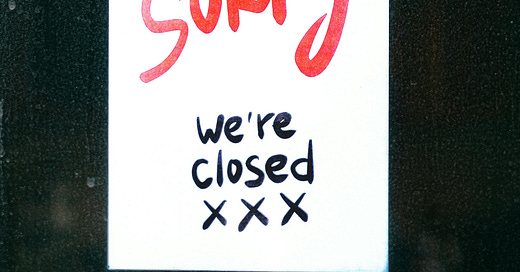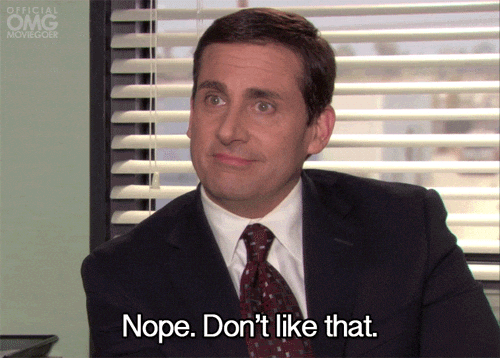Are More Art Galleries Closing Lately? And if so what would that Mean for Fairs, Artists, and the Future of Showing Art?
The gallery system is wobbling. But is that a crisis, or a moment of creative redistribution?
Hey there!
I caught up with a friend last week, someone who’s been orbiting the art world for years. Over a slightly oversteamed oat flat white, we did what most people in art do when they’re not making it: we gossiped. Names came up. Spaces we liked, admired, or knew about.
And then that moment: "Wait, they closed? Them too?" Feeling a mix of surprise and wonder.
Without any drama or scandal (that we know of). Just more galleries… gone.
It got me thinking.
Are galleries really disappearing faster than before? Or do we just notice it more now? What does it actually mean when the neighborhood spot that gave a young artist their first show quietly shuts its doors?
How does that ripple out? Are art fairs the next domino? What happens to the people who built whole careers around these spaces? Artists, of course, but also installers, interns, curators, and everyone else who makes it all happen.
The Digital Push, The Physical Pullback
It’s no secret the art world went digital, quickly in the wake of covid. Online art sales I read are now a nearly $12 billion chunk of the market. Buying art through Instagram DMs or platform links is normal. The idea of needing to walk into a gallery? Not so much.
For some, this is a dream. Artists can reach collectors directly. Collectors don’t need to navigate dealer relationships. It’s all faster, lighter, easier.
If you're a small or mid-sized gallery trying to cover rent in a major city while competing with influencers and algorithms, it might not feel like one. Some simply couldn’t keep up, not with the shift in traffic, not with the digital investment, not with the new rhythm of the game.
Who’s Actually Closing?
Big players still stand. The mega-galleries? Still here, still massive. No worries there.
But the independents? The ambitious in-betweeners? The ones who hosted weird group shows, took chances on emerging artists, stayed open late for neighborhood strolls?
Those are the ones we seem to be losing.
Sometimes it’s rent. Sometimes it's burnout. Sometimes it’s just time. But whatever the reason, it leaves a hole, not just in the street but in the way we experience art.
Back in 2007, you’d see five new galleries open for every one that closed. Now? They're barely breaking even.
And What About Art Fairs?
Fairs used to be the grand finale, the place to be seen, sell out, survive another year.
Now, they’re more of a gamble.
Smaller galleries are stepping back. The costs are high. The pace is relentless. And sometimes it feels like visitors scroll through booths the way they scroll through a feed too quickly, without pause.
Sales from fairs used to make up nearly half of gallery revenue. In 2023? Just 29%.
That’s not a small drop. That’s a signal.
Some galleries are rethinking the whole setup. Pop-ups. Collaborations. Staying close to their collectors instead of chasing them around the globe.
Others are investing in digital infrastructure, launching their own platforms, building loyal audiences directly. Some turn to hybrid models, hosting smaller shows while expanding their online sales presence. Others partner with alternative spaces, artist-run initiatives, or even retail concepts to show work in new ways. Some simply go nomadic, using flexible rentals or international residencies as new exhibition models.
So Where Do We Go From Here?
Is this a tragedy, or just a rebalancing?
Maybe it’s not about losing something essential, but about shifting into something less familiar.
The gallery isn’t vanishing. It’s adapting. Mutating. Getting leaner, more flexible, harder to pin down.
Fairs might follow suit, becoming smaller, more curated, regional, even slower. Less jet lag, more meaning?
And what if that’s not a bad thing?
The Conversation I Keep Having With Myself
Will we miss the gallery because it’s truly irreplaceable? Or because it means something that feels stable, even if it isn't always perfect?
Are we still romanticizing white walls and opening nights?
Can a website or a Zoom visit really create that same sense of discovery?
What does this tell us? What are we learning from this?
Art is still happening. Artists are still making. People are still connecting. Maybe something better is forming in the gaps. Something more flexible, more accessible, maybe even more interesting.
When will we truly feel the shift? Soon? Still a while to go? It's hard to say. Things are moving fast, but I like to think that through adaptation and openness, galleries and fairs will keep finding ways to thrive.
At least I hope so!
Subscribe if you’re into: Thinking out loud about art, the world, and what’s next. Weekly-ish. No fluff. Some spirals. Always human.










I never thought of this! I live in an area that doesn't have a lot (or maybe any) independent art galleries. But love going to art galleries! I love seeing the art in person because I feel like the art speaks to me more. I think galleries and art fairs will have to adapt to a hybrid model survive, which is a little sad for me but I would rather them survive than close down.